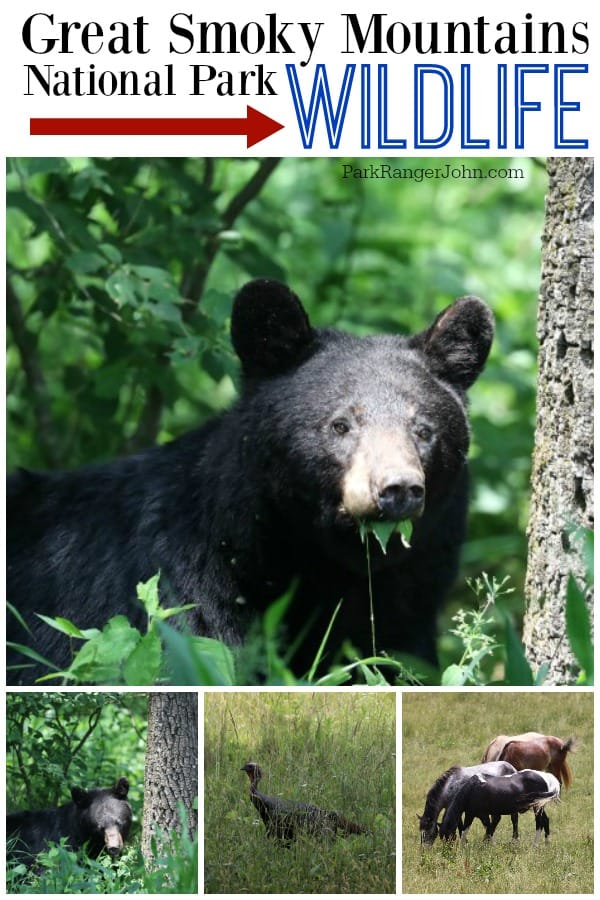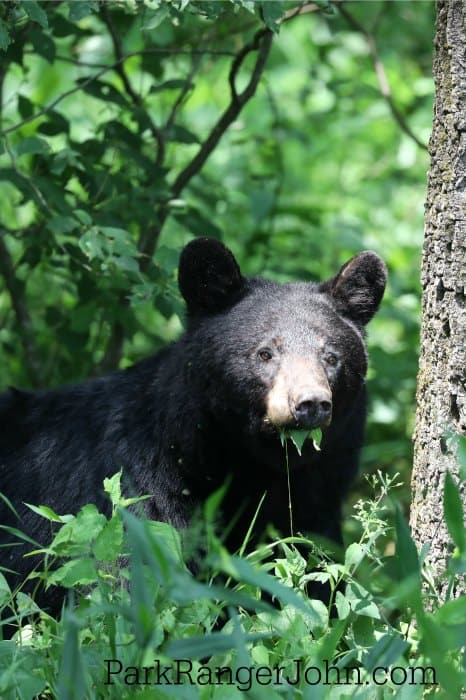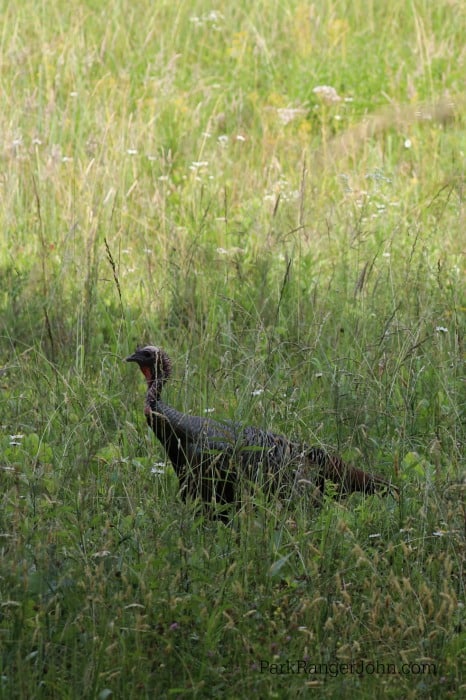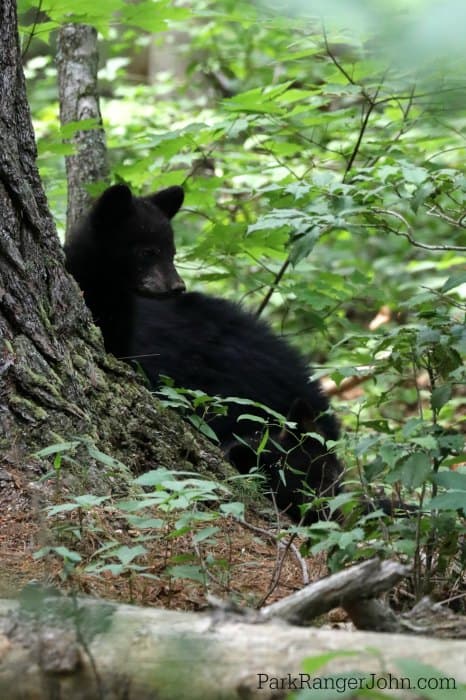The Great Smoky Mountains National Park is home to over 66 mammals, 240 species of birds, 80 reptiles and amphibians and 50 native fish within a half a million acres. There is a great opportunity to see the Great Smoky Mountains National Park Wildlife during a visit to the park.
There are 1,660 wild flowering plants and 1,600 bears in the Great Smoky Mountains National Park. There are also Deer and Elk. and many other animals and species.

Great Smoky Mountains National Park Wildlife
Wildlife photographers and nature lovers converge in the park to catch a fleeting glimpse of one of the 1,500 black bears that call the park home.

The Great Smoky Mountains National Park is located within the Appalachian Mountain Range along the east coast of the United States and Canada. The Great Smoky Mountains National Park consists of 814 square miles in the states of Tennessee and North Carolina.
Viewing wildlife in the park is a challenge at best. Because of the dense forest surrounding the mountains, many of the animals that live in the park, also hide in the park.
The best viewing is found at Cades Cove, a valley that was formerly home to the Cherokee Indians' favorite hunting grounds. While the Cherokee never inhabited the valley, the European settlers did. This valley now is home to one of the largest varieties of historical buildings in the East.
One can find the likes of the white-tailed deer, black bear, raccoons, turkeys, and many of the other residents of the Smoky Mountains enjoying a meadow morning in Cades Cove.
The best viewing of all wildlife is in the early morning or the early evening hours. This is the most active time for wildlife and it is best to sit and wait on them. Quiet patience usually pays off.
Northern species that normally are not found as far south as the Smoky Mountain range can be found here because of the climate that is available to them in the upper altitudes of the mountains. The cool and moist air of the upper elevations provides a home to the northern flying squirrel, the red squirrel, and the rock vole.
The same climate that is suitable for the squirrels is also a southernmost breeding point for the Common Raven, Canada Warbler, and the Saw-whet Owl.

Prior to the establishment of the Great Smoky Mountains National Park in 1934, many of the native animals had been hunted out of existence. The National Park System has been instrumental in providing sanctuary for endangered animals, fish, insects, and plants, throughout the United States.
Some of the re-introduced animals to the Great Smoky Mountains National Park have been the river otter, elk, and peregrine falcon.
Additionally, some of the endangered species that currently reside in the park include red-cockaded woodpecker, Indiana bat, spruce-fir moss spider, and the smoky madtom. The park has been working diligently to keep these from going extinct as well.
Wildlife is not mammal exclusive; the 240 species of birds in the park create a birdwatcher’s nirvana. From the top of the highest peaks of spruce-fir, where the black-capped chickadee can be found nesting, to the open fields where the red-tailed hawk and the wild turkey are found, one can find a feathered feast for the eyes.
The Great Smoky Mountains Park has the nickname “Salamander Capital of the World”. It is said that the climate and the geological factors have combined to create a climate that has allowed for certain salamander species to diversify so much, that this is the only place that they are all located.
Fish can be included as well.
Over 50 native fish species can be found in the 700 miles of streams located in the park. The park has been able to re-introduce four endangered species into the waterways.
They now have the Smoky madtom, duskytail darter, yellowfin madtom, and the spotfin chub.
Sadly, local extinction has claimed the grey wolf, the red wolf, and the eastern cougar. In addition, they all find themselves on the endangered species list at a national level.
The wildlife abounds in this protected area and whether you are an amateur birder or professional photographer, the Great Smoky Mountains National Park is rich in opportunities to view wildlife in its natural habitat.

Camera Gear we use
We are big fans of using great camera gear to get amazing photos while traveling.
Canon R5 - We recently upgraded to the R5 after using a Mark 5 for years. We are loving the camera shutter speed and quality of images.
Canon 100 - 500mm - We use the Canon 100-500 for wildlife photography.
Camera Rain Cover - A rain cover will help protect your camera during rain showers but also when photographing waterfalls.
Camera Cleaning Kit - Cameras can get dirty, beat up, and dusty while in the parks. We like having a cleaning kit with us so we can do on the spot touch ups.
Extra Camera Batteries - We suggest always having one or two extra camera batteries with you. There is nothing worse than going to take a shot and the battery dies.
Extra Memory Cards - We use Extreme PRO SanDisk cards
Where to stay when visiting Great Smoky Mountain National Park
There are many options right outside of the park in Gatlinburg and Pigeon Forge, Tennessee.
There is one park lodge the LeConte Lodge which you visitors need to hike into.
LeConte Lodge
Sitting at 6,643 ft, just shy of the Mountain LeConte peak at 6,593 feet, is the LeConte Lodge. This beautiful property is the only Lodge within the National Park.
It boasts spectacular unobstructed views of the mountains and the valley; however, it is only accessible by foot (which you’ll have to follow with your supplies).
There are five trails that will lead you to this historic site - Alum Cave Trail, Boulevard Trail, Bullhead Trail, Rainbow Falls Trail, and Trillium Gap Trail, each varying in distance and elevation, so be sure to plan.
The Lodge is entirely old-school (has no water or electricity), so you’ll have plenty of time to just soak in the breathtaking scenery and picturesque mountains. The Lodge doesn’t offer much beyond the basic amenities and serves regular family-style Southern food for breakfast, lunch, and dinner.
If you’re looking to detox from any electronics and just become one with nature under the twilight sky, the LeConte Lodge situated high up in the mountains is the perfect place to spend the night.
You can make a reservation at the Lodge by calling: (865) 429-5704 or emailing reservations@lecontelodge.com.
Lodging near Great Smoky Mountains NP
Fairfield Inn & Suites by Marriott Gatlinburg - We have stayed in this hotel the past few times we visited the park and it has been great. Fairfield Inn & Suites by Marriott Gatlinburg Downtown provides free continental breakfast, a terrace, and dry cleaning/laundry services. For some rest and relaxation, visit the hot tub. Stay connected with free in-room Wi-Fi, and guests can find other amenities such as a fireplace in the lobby and a gym.
Margaritaville Resort Gatlinburg - Located close to Ripley's Aquarium of the Smokies, Margaritaville Resort Gatlinburg provides a firepit, a coffee shop/café, and a garden. Indulge in a massage, a body scrub, and a facial at St. Somewhere Spa, the onsite spa. Enjoy a meal at the two onsite restaurants. Free in-room Wi-Fi is available to all guests, along with laundry facilities and a bar.
Hampton Inn Gatlinburg - Hampton Inn Gatlinburg Historic Nature Trail provides free self-serve breakfast, a firepit, and a garden. Free in-room Wi-Fi is available to all guests, along with dry cleaning/laundry services and a gym.
Glenstone Lodge - Glenstone Lodge provides amenities like a terrace and a 24-hour business center. Stay connected with free in-room Wi-Fi.
The Park Vista - a DoubleTree by Hilton Hotel - provides a terrace, a garden, and a playground. For some rest and relaxation, visit the hot tub. Enjoy a meal at the two onsite restaurants. In addition to dry cleaning/laundry services and a fireplace in the lobby, guests can connect to free Wi-Fi in public areas.
Hilton Garden Inn Gatlinburg - provides golfing on site, dry cleaning/laundry services, and a fireplace in the lobby. For some rest and relaxation, visit the hot tub. The onsite restaurant, Garden Grille, features happy hour. Free in-room Wi-Fi is available to all guests, along with a bar and a gym.
Click on the map below to see additional hotels and vacation rentals near Great Smoky Mountains.
Make sure to follow Park Ranger John on Facebook, Instagram, Pinterest, and TikTok





Leave a Reply